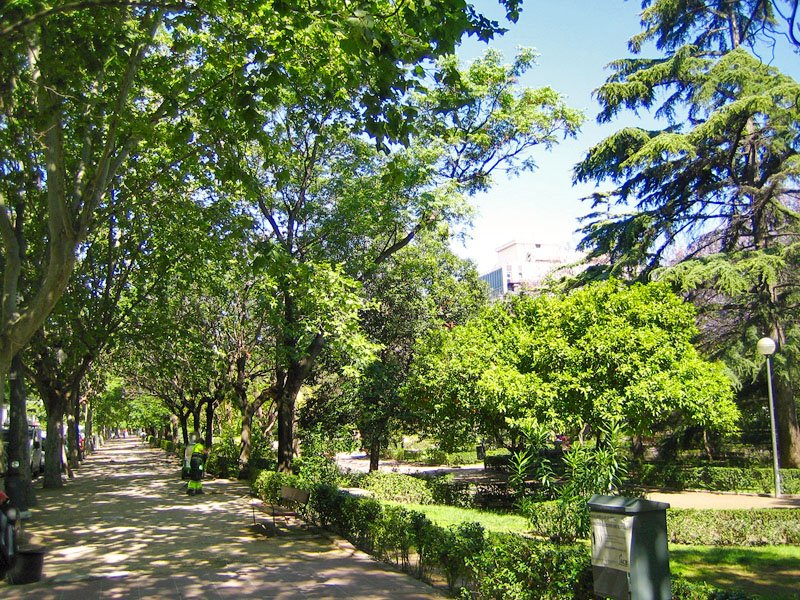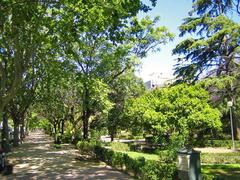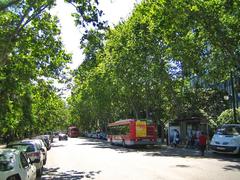
Avinguda De Vicent Blasco Ibáñez: Visiting Hours, Tickets, and Travel Guide in Valencia, Spain
Date: 15/06/2025
Introduction
Avinguda De Vicent Blasco Ibáñez is one of Valencia’s most prominent and historically significant boulevards, reflecting the city’s evolution from the late 19th century to its contemporary vibrancy. Stretching nearly three kilometers from the lush Jardines del Real (Viveros Gardens) to the edges of the Mediterranean coast and the historic El Cabanyal district, the avenue is a living tribute to its namesake, Vicente Blasco Ibáñez—a celebrated Valencian novelist, journalist, and political figure. Today, the boulevard stands as an urban artery that seamlessly blends green promenades, diverse architecture, academic institutions, and dynamic social life. This guide provides a comprehensive overview of the avenue’s history, cultural landmarks, practical visitor information, and insider tips for making the most of your visit to this emblematic part of Valencia (Valencia City Council; Visit Valencia; Wikipedia).
Table of Contents
- Historical Overview
- Urban and Cultural Significance
- Visitor Information
- Nearby Attractions
- Dining and Nightlife
- Events and Social Life
- Practical Tips and Accessibility
- FAQ
- Conclusion
- References and Further Reading
Historical Overview
Origins and Urban Planning
Avinguda De Vicent Blasco Ibáñez originated in the late 19th century as part of Valencia’s ambitious urban expansion. Initially envisioned as the “Paseo de Valencia al Mar,” the avenue was designed to link the historic city center with the sea, inspired by European “garden city” models. Architect Casimiro Meseguer’s grand plan, influenced by urban planners Ebenezer Howard and Arturo Soria, called for a wide boulevard with landscaped medians and monumental plazas, integrating both bourgeois villas and affordable housing (Valencia City Council). While financial and practical constraints led to a more modest realization, the boulevard’s broad, tree-lined central median remains a defining feature.
20th Century Evolution
The avenue’s development paralleled Valencia’s modernization, quickly becoming a symbol of the city’s progress. During the Spanish Civil War, its name was temporarily changed to “Avenida de la Unión Soviética,” before reverting after Franco’s regime. From the 1970s onward, further expansions sought to extend the avenue to the sea, but these plans faced resistance due to concerns about preserving the historic Cabanyal neighborhood (Culturavalenciana.es; Wikipedia).
Dedication to Vicente Blasco Ibáñez
In 1977, the avenue was officially named after Vicente Blasco Ibáñez, and a monument was erected in his honor in 1980. The writer’s legacy is celebrated through local festivals, literary events, and the nearby Casa Museo Blasco Ibáñez (24/7 Valencia).
Urban and Cultural Significance
Academic and Social Hub
Avinguda De Vicent Blasco Ibáñez is a central axis of academic life in Valencia, housing several University of Valencia faculties such as Medicine, Psychology, and Philology. The student population brings a cosmopolitan energy, reflected in the abundance of bookstores, cafés, and cultural venues lining the boulevard (Visit Valencia).
Architectural and Artistic Highlights
The avenue features an eclectic architectural mix, from Neo-Mudéjar and Art Deco facades to contemporary university buildings. Public art installations, murals, and statues—including the monument to Blasco Ibáñez—enrich the streetscape and underscore the area’s creative spirit.
Green Spaces
Its iconic central median, planted with palms and flowering shrubs, offers a shaded, pedestrian-friendly promenade. Benches and playgrounds provide a relaxing environment for both residents and visitors.
Preservation and Community
Repeated proposals to extend the avenue to the sea have sparked debate over the preservation of the Cabanyal district, designated a Bien de Interés Cultural. The area remains a key site for civic activism and cultural heritage (Wikipedia).
Visitor Information
Visiting Hours and Tickets
- Avinguda De Vicent Blasco Ibáñez: Open 24/7, year-round, with free public access.
- Casa Museo Blasco Ibáñez:
- Address: Calle Isabel de Villena, 157
- Hours: Tuesday to Saturday, 10:00–14:00 & 15:00–19:00; Sundays and holidays, 10:00–14:00
- Admission: €2 (discounts for students, seniors, free with Valencia Tourist Card & on Sundays) (Visit Valencia - Casa Museo Blasco Ibáñez)
Accessibility
- Transport: Served by multiple EMT bus lines and Metrovalencia stations (Amistat-Casa de Salud, Facultats, Benimaclet).
- Cycling and Walking: Dedicated bike lanes and wide sidewalks; Valenbisi bike-sharing stations available.
- Mobility: Wheelchair-accessible sidewalks, ramps, and accessible public transit options.
Getting There
- From the airport: Metrovalencia lines 3 or 5 to Amistat-Casa de Salud or Facultats.
- From the historic center: EMT buses or a 30-minute walk.
Nearby Attractions
- Jardines del Real (Viveros Gardens): Historic urban park with botanical collections and cultural spaces.
- Monforte Gardens: Neoclassical gardens with statues and ornamental fountains (Monforte Gardens).
- El Cabanyal Neighborhood: Colorful historic fishing district near the coast.
- Malvarrosa Beach: Accessible via public transport or a 20-minute walk east (Malvarrosa Beach).
- Benimaclet: Bohemian neighborhood with traditional houses, alternative cultural venues, and nightlife.
- City of Arts and Sciences: Landmark complex accessible by bus or metro.
Dining and Nightlife
- Restaurants and Cafés: Range from traditional Valencian cuisine (paella, horchata) to international eateries (Abroad in Valencia).
- Bars and Clubs: Lively student nightlife, especially during university term; nearby La Casa de la Mar hosts live music and events (Visit Valencia - La Casa de la Mar).
- Markets: Local markets and shops offer fresh produce and regional specialties.
Events and Social Life
- Academic and Cultural Events: Public lectures, exhibitions, literary festivals, and street markets are frequent, supported by university faculties and the Casa Museo Blasco Ibáñez (Visit Valencia).
- Festivals: The avenue comes alive during citywide events like Las Fallas in March, with parades and fireworks.
Practical Tips and Accessibility
- Museum Visits: Take advantage of free museum entry on Sundays for budget-friendly sightseeing.
- Dining: For authentic paella, choose reputable beachside spots over tourist areas.
- Shopping: Note siesta hours (approx. 2:30–5:00/6:00 pm) when some shops close.
- Transport: Use the Valencia Tourist Card for unlimited public transport and attraction discounts.
- Safety: The area is generally safe; standard urban precautions apply.
- Language: Spanish and Valencian are spoken; signage is often bilingual.
- Wi-Fi: Available in cafés, hotels, and some public spaces.
FAQ
Q: Are there tickets or entrance fees to visit the avenue?
A: No, Avinguda De Vicent Blasco Ibáñez is a public street open 24/7 and free to visit.
Q: How do I reach the avenue from the airport or train station?
A: Use Metrovalencia lines 3 or 5 to Amistat-Casa de Salud or Facultats stations, or EMT bus lines.
Q: Are guided tours available?
A: Yes, many walking and cycling tours include the avenue in their itineraries; check with local operators or the official tourism website.
Q: Is the avenue accessible for visitors with reduced mobility?
A: Yes, the avenue features wide sidewalks, ramps, and accessible public transport.
Q: What are the best times to visit?
A: Spring and autumn offer the most pleasant weather; the avenue is lively during university terms and festivals.
Q: Where are the best photo opportunities?
A: The central median, university buildings, Monforte Gardens, and murals in nearby neighborhoods.
Conclusion
Avinguda De Vicent Blasco Ibáñez is more than just a thoroughfare—it is a microcosm of Valencia’s historic, cultural, and academic life. With its blend of green spaces, distinctive architecture, vibrant student scene, and proximity to both the city’s historic heart and the Mediterranean, the avenue is an essential stop for any Valencia itinerary. Take time to explore its monuments, savor local cuisine, and immerse yourself in the dynamic social fabric that defines this iconic boulevard.
For up-to-date information on events, guided tours, and transport, download the Audiala app and consult official tourism resources. Experience Valencia’s living history and modern pulse as you stroll down Avinguda De Vicent Blasco Ibáñez.
References and Further Reading
- Valencia City Council
- Visit Valencia
- Wikipedia
- 24/7 Valencia
- Culturavalenciana.es
- OpenAlfa
- Abroad in Valencia
- Moovit
- The Crazy Tourist
- Touropia
- Monforte Gardens
- Malvarrosa Beach
- Visit Valencia - Casa Museo Blasco Ibáñez
- Visit Valencia - La Casa de la Mar












































